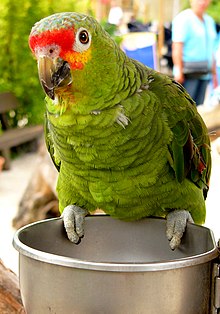Tameness
Under tameness is meant fearlessly and aggression-free behavior of animals to humans or other species which can be made either by nature or by taming is learned. Tameness occurs next to domesticated animals and pets even in wild animals , which do not know the people or the appropriate type as a threat. This can be fatal for individual species, such as the dodo ( Raphus cucullatus ), whose familiarity accelerated its extinction.
In a figurative sense, the term is also used as the opposite of wildness to other objects, for example generally to the calm water of rivers - so-called " tame water " in contrast to white water - or the specific river name " Tame Gera ".
etymology
The Brothers Grimm note in their German dictionary : “ Tame is the opposite of wild .” It is derived from Old High German zam , Middle High German zæme has a related meaning with “befitting”, “fitting”, “pleasant”. It is a root to which also Zimmer , Zimmer and the like go back, in the original meaning of to add - to make minor or possibly adapt the meaning to the house . The underlying Indo-European root dem- , from which “dämmen” and “dam” can be derived, meant something like “to build”. So it has always been used primarily in relation to the training and domestication of animals.
function
Tameness plays the role of a selection criterion in animal breeding , since tame animals are usually more cooperative and receive advantages (more food, reward, reproduction) through this behavior.
Web links
Individual evidence
- ↑ tame. In: Jacob Grimm , Wilhelm Grimm (Hrsg.): German dictionary . tape 31 : Z-Zmasche - (XV). S. Hirzel, Leipzig 1956, Sp. 93–122 ( woerterbuchnetz.de ).
- ^ Friedrich Kluge: Etymological dictionary. de Gruyter, Berlin / New York 1995, ISBN 3-11-012922-1 .
- ^ Friedrich Kluge , Alfred Götze : Etymological dictionary of the German language . 20th ed., Ed. by Walther Mitzka , De Gruyter, Berlin / New York 1967; Reprint (“21st unchanged edition”) ibid 1975, ISBN 3-11-005709-3 , p. 120 ( Damm ) and 872 ( tame ).
- ^ Carola Otterstedt: Companions - Competitors - Relatives: The human-animal relationship in scientific discourse. Vandenhoeck & Ruprecht, 2009. ISBN 3-525-40422-0 , p. 68.
- ↑ Peter M. Kappeler: Behavioral Biology. Springer, 2005. ISBN 3-540-24056-X , p. 447.
